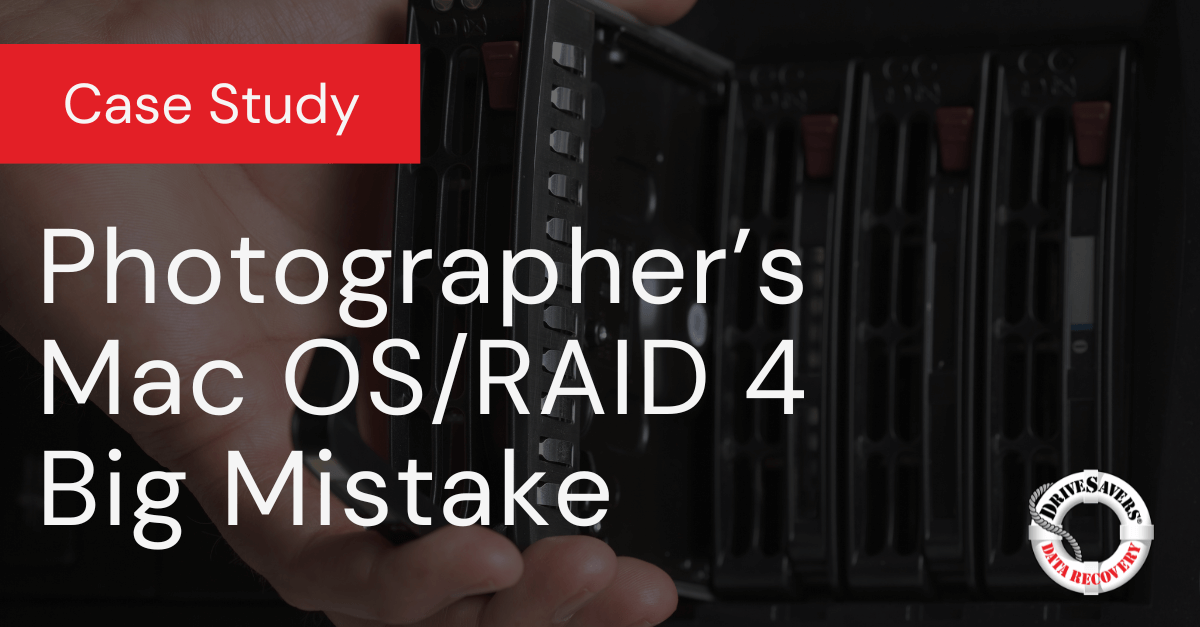See how DriveSavers used advanced flash drive and chip-off USB data recovery to rescue critical legal documents and save a paralegal business from total data loss.
Mac OS RAID 4 with Compromised Configuration
A RAID 4 setup uses block-level striping with a dedicated parity disk. This setup splits data into blocks and writes them across multiple disks while storing parity information on a separate disk.
RAID 4 utilizes a single disk for redundancy, while RAID 5 and RAID 6 distribute redundancy across all drives in the RAID. It offers high read performance, as data can be read from multiple disks simultaneously, and all parity information is centralized on a single disk, making it easier to manage.
However, RAID 4 has limitations: the parity disk can become a bottleneck during write operations, as it needs to be updated each time data is written, and, most importantly, RAID 4 can only tolerate one disk failure.
RAID 4 is very rare these days. Today, RAID 5 is generally chosen over RAID 4 because RAID 5 distributes parity across all disks, avoiding the write bottleneck of a dedicated parity disk and offering better storage efficiency and fault tolerance. This results in improved overall performance and reliability compared to RAID 4.
The photographer’s data was stored on four 20TB Toshiba SATA drives, configured in a soft RAID 4 with one drive parity running on a Mac operating system. The system, housed in an 8-bay unit, originally used only four of the bays.
The issue arose when the photographer attempted to add four new drives to create a second volume. Unfortunately, during this process, two drives from the original volume were accidentally removed and incorporated into the new configuration. This left the original volume with a compromised RAID configuration, as only the parity drive and one other drive remained untouched.
The recovery process was particularly challenging due to the presence of Time Machine backups and a very large HFS+ Private Directory. This directory served as a hub for “hard linked” files, where multiple inodes pointed to the same piece of data, creating a significant number of reference points on the system.
Additionally, many of the files were compressed JPEGs, which complicated the RAID reconstruction. The RAID 4 configuration, though rare nowadays due to RAID 5’s increased redundancy and similar capacity, added to the complexity.
Faced with this complex scenario, DriveSavers data recovery engineers worked together to develop a custom recovery solution.
Data recovery starts by making a clone of each drive involved in the recovery process and a second clone as a backup so all data is preserved and backed up in the original failed state. Once these steps were complete, the engineers used advanced data recovery techniques to extract the needed data.
Through meticulous diligence, DriveSavers engineers were able to access the RAID drives and recover 55TB of lost files. The process involved piecing together the RAID array from the remaining drives and ensuring the integrity of the recovered files.
This recovery was akin to piecing together a very large puzzle where several pieces had been swapped with those from a similar-looking puzzle, making it difficult to determine which pieces belonged to which puzzle. The expertise of the DriveSavers data recovery engineers in Mac OS recovery and RAID recovery was crucial to restoring the data.
The RAID system SATA drive recovery was highly successful. DriveSavers managed to recover all original data with the structure intact. The professional wildlife photographer received the critical photo files in their original formats, including RAW, JPG, and TIFF.
This case demonstrates DriveSavers Data Recovery’s capability to manage challenging data loss situations. The proficiency in RAID array data recovery and Mac recovery required for this situation shows the data recovery engineers’ ability to address complex data recovery issues effectively, think creatively, and invent custom solutions.
*DriveSavers Standard Turnaround times are 1-2 Business days, Economy 5-7 Business days, and Priority 24/7 service – on occasion, unique circumstances require more time and are approved by the customer.






